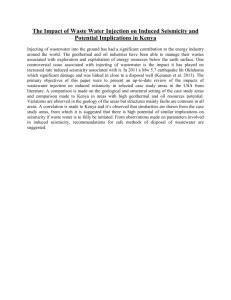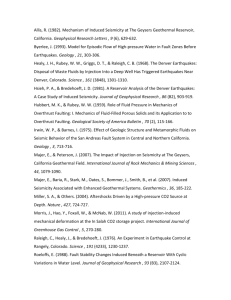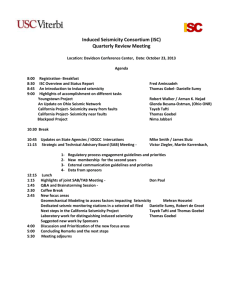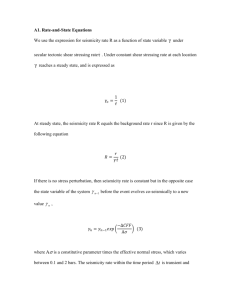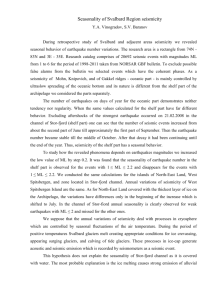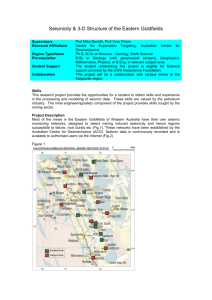Induced Seismicity Potential in Energy Technologies
advertisement
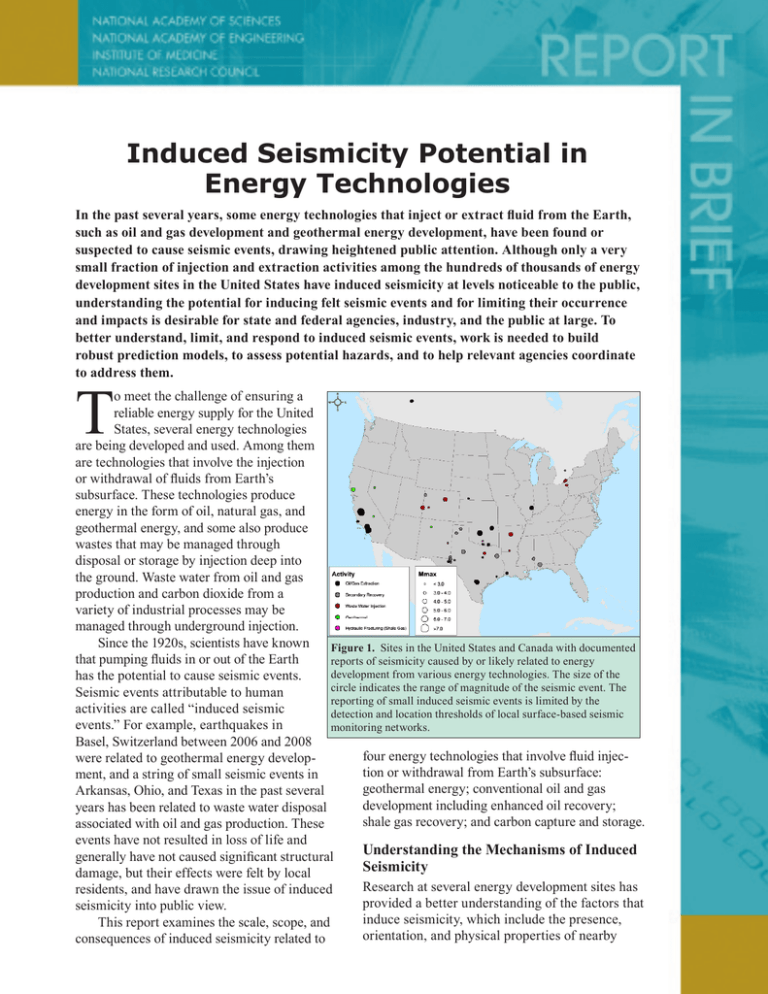
Induced Seismicity Potential in Energy Technologies In the past several years, some energy technologies that inject or extract fluid from the Earth, such as oil and gas development and geothermal energy development, have been found or suspected to cause seismic events, drawing heightened public attention. Although only a very small fraction of injection and extraction activities among the hundreds of thousands of energy development sites in the United States have induced seismicity at levels noticeable to the public, understanding the potential for inducing felt seismic events and for limiting their occurrence and impacts is desirable for state and federal agencies, industry, and the public at large. To better understand, limit, and respond to induced seismic events, work is needed to build robust prediction models, to assess potential hazards, and to help relevant agencies coordinate to address them. T o meet the challenge of ensuring a reliable energy supply for the United States, several energy technologies are being developed and used. Among them are technologies that involve the injection or withdrawal of fluids from Earth’s subsurface. These technologies produce energy in the form of oil, natural gas, and geothermal energy, and some also produce wastes that may be managed through disposal or storage by injection deep into the ground. Waste water from oil and gas production and carbon dioxide from a variety of industrial processes may be managed through underground injection. Since the 1920s, scientists have known Figure 1. Sites in the United States and Canada with documented that pumping fluids in or out of the Earth reports of seismicity caused by or likely related to energy development from various energy technologies. The size of the has the potential to cause seismic events. circle indicates the range of magnitude of the seismic event. The Seismic events attributable to human reporting of small induced seismic events is limited by the activities are called “induced seismic detection and location thresholds of local surface-based seismic events.” For example, earthquakes in monitoring networks. Basel, Switzerland between 2006 and 2008 four energy technologies that involve fluid injecwere related to geothermal energy develoption or withdrawal from Earth’s subsurface: ment, and a string of small seismic events in geothermal energy; conventional oil and gas Arkansas, Ohio, and Texas in the past several development including enhanced oil recovery; years has been related to waste water disposal shale gas recovery; and carbon capture and storage. associated with oil and gas production. These events have not resulted in loss of life and Understanding the Mechanisms of Induced generally have not caused significant structural Seismicity damage, but their effects were felt by local Research at several energy development sites has residents, and have drawn the issue of induced provided a better understanding of the factors that seismicity into public view. induce seismicity, which include the presence, This report examines the scale, scope, and orientation, and physical properties of nearby consequences of induced seismicity related to faults, the volumes, rates, pressures, and temperatures of fluids being injected or withdrawn, and the rock properties of Earth’s subsurface in that location. In general, existing faults and fractures are stable, but a change in subsurface pore pressure—the pressure of fluid in the pores and fractures of rock—for example due to the injection or extraction of fluid from Earth’s subsurface, may change the crustal stresses acting on a nearby fault, creating a seismic event. Net fluid balance (the total balance of fluid introduced into or removed from the subsurface) appears to have the most direct correlation to the magnitude of induced seismic events. Thus, energy technology projects that maintain a balance between the amount of fluid injected and the amount withdrawn may induce fewer felt seismic events than technologies that do not maintain balance. While the general mechanisms that create induced seismic events are well understood, scientists are currently unable to accurately predict the magnitude or occurrence of such events due to the lack of comprehensive data on the complex natural rock systems at particular energy development sites. Predictions of induced seismicity at specific energy development sites will continue to rely on both theoretical modeling, and data and observations from measurements made in the field. Energy Technologies Of all the energy-related injection and extraction activities conducted in the United States, only a very small fraction have induced seismicity at levels noticeable to the public (that is, above magnitude 2.0). Different energy technologies typically use different injection rates and pressures, fluid volumes, and injection duration—factors that affect the likelihood and magnitude of an induced earthquake. Geothermal energy extraction Geothermal energy is the use of heat from the Earth as an energy source. There are three different types of geothermal energy resources: vapor-dominated, where steam is contained in pores or fractures of hot rock; liquid dominated, where hot water is contained in the rock; and enhanced geothermal systems, where hot, dry rock is fractured and a fluid is injected to circulate and heat. All three processes usually attempt to maintain a balance between fluid volumes extracted for energy production and those replaced by injection, which helps keep reservoir pressure constant and reduces the Domestic Well potential for induced seismicity. However, there are site-specific characteristics that can make a difference. For example, the high-pressure hydraulic fracturing undertaken to produce geothermal energy from hot, dry rocks has caused seismic events that are large enough to be felt. In The Geysers geothermal steam field in northern California, a vapor-dominated geothermal system, the large temperature difference between the injected fluid and the geothermal reservoir results in significant cooling of the hot subsurface rocks. This causes the rocks to contract and allows the release of local stresses that result in significant induced seismicity that is not directly related to change in pore pressure. Oil and gas development Conventional oil and gas development extracts oil, gas, and water from pore spaces in rocks in subsurface reservoirs. Well bores penetrate rock that is under significant natural pressure, allowing oil and water within the reservoir to flow to the surface, usually aided by pumping. Once the pressure in the oil and gas reservoirs declines, additional techniques such as secondary recovery and tertiary recovery (the latter is often called enhanced oil recovery) can be used to extract some of the remaining oil and gas. More than 100,000 wells are presently used for secondary recovery; over the past several decades approximately 18 sites have been linked to incidences where the injection was suspected or determined a likely cause for induced seismicity. Among the tens of thousands Drilling Rig & Treatment Well Microseismic Monitoring Well Figure 2. Schematic diagram of a shale gas well following hydraulic fracture treatment, with the relative depths of local water wells shown for scale. Formation depths and horizontal well length varies; numbers shown are approximate length and depth averages in North America. The upper right inset shows the fractures (yellow) created during hydraulic fracture treatment in stages. SOURCE: Adapted from Southwestern Energy. of wells used for enhanced oil recovery in the United States, incidences of felt induced seismicity appear to be very rare. Shale formations may contain oil, gas, and/or liquids. Shales have very low permeability that prevent these fluids from easily flowing into a well bore, and so wells may be drilled horizontally and hydraulically fractured to allow hydrocarbons to flow up the well bore. Hydraulic fracturing to date has been confirmed as the cause for small, felt seismic events at one location in the world. Wastewater Disposal Wells Injection wells can be drilled to dispose of the water generated by geothermal and oil and gas production operations, including shale gas production. Tens of thousands of waste water disposal wells are currently active in the United States; water injection for disposal has been suspected or determined a likely cause for induced seismicity at approximately eight sites in the past several decades. However, the long-term effects of increasing the number of waste water disposal wells on the potential for induced seismicity are unknown. In addition, wells used only for waste water disposal usually do not undergo detailed geologic review prior to injection, in contrast to wells for enhanced oil recovery and secondary recovery. felt seismic events due to increases in pore pressure over time; potential effects of large-scale carbon capture storage projects require further research. Hazards and Risk Assessment Understanding what is meant by hazard and risk related to induced seismicity is critical to any discussion of the options. The hazard of induced seismicity considers the earthquakes and other physical effects that could be generated by human activities associated with energy production or carbon sequestration. The risk of induced seismicity considers how induced earthquakes might cause damage to structures and human injuries or deaths. If seismic events occur in areas where there are no structures or humans present, there is no risk. Currently, there are no standard methods to implement risk assessments for induced seismicity. The types of information and data required to provide a robust risk assessment include net pore pressures and stresses; information on faults; data on background seismicity; and gross statistics of induced seismicity and fluid injection or extraction. Quantifying hazard and risk requires probability assessments, which may be either statistical (based on data) or analytical (based on scientific and engineering models). These assessments can help establish specific “best practice” protocols for energy project development, which aim to reduce the possibility of a felt seismic event, and to mitigate the effects of an event if Carbon Capture and Storage Capturing carbon dioxide and developing means to store it underground could, if technically successful and Table 1. Felt Induced Seismic Events Related to Energy Technology in the economical, help reduce United States carbon dioxide emissions to Number Number of Number of Current Historical Felt of Events Locations of the atmosphere. Limited Energy Technology Projects Events M>4.0 Events M>2.0 data are available to evaluate Geothermal the induced seismicity Vapor-dominated (The 1 300-400 per 1 to 3 per CA potential of this technology. Geysers) year since 2005 year However, carbon capture Liquid-dominated 23 10-40 per year Possibly one CA and storage differs from Enhanced Geothermal ~8 pilot 2-10 per year 0 CA other energy technologies System because it involves the Oil and gas continuous injection of very Withdrawal ~6,000 fields 20 sites 5 CA, IL, NB, large volumes of carbon OK, TX dioxide under high pressure, Secondary recovery ~108,000 wells 18 sites 3 AL, CA, CO, and is intended for long term (waterflooding) today MS, OK, TX storage with no fluid withEnhanced Oil ~13,000 wells None known None known None known drawal. The large net Recovery today volumes of carbon dioxide— Hydraulic fracturing ~35,000 wells 1 0 OK on the scale suggested to for shale gas recovery today help reduce global carbon Waste water disposal ~30,000 wells 8 7 AR, CO, OH dioxide emissions to the wells (Class II) today atmosphere—may have Carbon capture and 1 None known None known None known storage (small scale) potential for inducing larger one should occur. A “traffic light” control system within a protocol can be established to respond to an instance of induced seismicity, allowing for low levels of seismicity but adding monitoring and mitigation requirements if induced seismic events increase in magnitude or frequency. Government Roles and Responsibilities Four federal agencies—the U.S. Environmental Protection Agency, the Bureau of Land Management, and the U.S. Department of Agriculture Forest Service and the U.S. Geological Survey—and several different state agencies have regulatory oversight, research roles and responsibilities relating to different parts of the underground injection activities associated with energy technologies, but there are currently no mechanisms in place for the efficient coordination of governmental agency response to induced seismic events. The Environmental Protection Agency has primary responsibility for fluid injection under the Safe Drinking Water Act, which does not address induced seismicity. The Environmental Protection Agency is addressing the issue of induced seismicity through a current study in consultation with various other state and federal agencies. The United States Geological Survey has the capability and expertise to address monitoring and research associated with induced seismic events. However, the scope of its mission within the seismic hazard program is focused on large impact, natural earthquakes. Significant new resources would be required if the mission was expanded to include comprehensive monitoring and research on induced seismicity. Proposed Research Needs Research in five specific areas would help address gaps in the present understanding of induced seismicity. 1. Collecting field and laboratory data on active seismic events possibly caused by energy development and on specific aspects of the rock system at energy development sites (for example, on fault and fracture properties and orientations, injection rates, fluid volumes). 2. Developing instrumentation to measure rock and fluid properties before and during energy development projects. 3. Hazard and risk assessment for individual energy projects. 4. Developing models, including codes that link geomechanical models with models for reservoir fluid flow and earthquake simulation. 5. Conducting research on carbon capture and storage, incorporating data from existing sites where carbon dioxide is injected for enhanced oil recovery, and developing models to estimate the potential magnitude of seismic events induced by the large-scale injection of carbon dioxide for storage. Read or purchase this report and locate information on related reports at http://dels.nas.edu/besr Committee on Induced Seismicity Potential in Energy Technologies: Murray W. Hitzman (Chair), Colorado School of Mines, Golden; Donald D. Clarke, Geological Consultant, Long Beach, California; Emmanuel Detournay, University of Minnesota, Minneapolis and CSIRO (Earth Science and Resource Engineering), Australia; James H. Dieterich, University of California, Riverside; David K. Dillon, David K. Dillon PE, LLC, Centennial, Colorado; Sidney J. Green, University of Utah, Salt Lake City; Robert M. Habiger, Spectraseis, Denver, Colorado; Robin K. McGuire, Engineering Consultant, Boulder, Colorado; James K. Mitchell, Virginia Polytechnic Institute and University, Blacksburg; Julie E. Shemeta, MEQ Geo, Inc., Highlands Ranch, Colorado; John L. (Bill) Smith, Geothermal Consultant, Santa Rosa, California; Elizabeth A. Eide (Study Director), Jason Ortego (Research Associate), Courtney R. Gibbs (Program Associate), National Research Council. The National Academies appointed the above committee of experts to address the specific task requested by the U.S. Department of Energy. The members volunteered their time for this activity; their report is peer-reviewed and the final product signed off by both the committee members and the National Academies. This report brief was prepared by the National Research Council based on the committee’s report. For more information, contact the Board on Earth Sciences and Resources at (202) 334-2744 or visit http://dels.nas.edu/besr. Copies of Induced Seismicity Potential in Energy Technologies are available from the National Academies Press, 500 Fifth Street, NW, Washington, D.C. 20001; (800) 624-6242; www.nap.edu. Permission granted to reproduce this brief in its entirety with no additions or alterations. Permission for images/figures must be obtained from their original source. © 2012 The National Academy of Sciences
